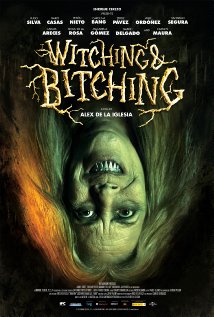
LAS BRUJAS DE ZUGARRAMURDI/WITCHING AND BITCHING
Spain, 2013, 112 minutes, Colour.
Hugo Silva, Mario Casas, Carolina Bang, Carmen Maura.
Directed by Alex de la Iglesia.
This is a film to check out before you see it. It is very much a cult film.
It is the work of director Alex de la Iglesia, who since the 1990s has built a reputation for films which are often quite over the top, blends of comedy, satire, films of horror all with a vivid visual style. This is definitely the case here – and the English language title, Witching and Bitching, is more over the top than the original Spanish title, The Fires of Zugarramurdi.
The film begins more than eccentrically with a robbery in broad daylight in the city square. Audience attention is arrested by the figure of Jesus carrying his cross, one of those life statues, motionless mime, that are seen frequently. In the square are quite a number of other motionless mimes as well as comic characters including Mickey and Minnie Mouse. Suddenly there is Jesus taking a mobile phone from his loincloth and running across the street, all the characters converging on the jewellery shop where there is a store of gold rings which are taken by the thieves. Also implicated is the little son of the thief who is Jesus, a little boy who makes contact with his father, who should be doing his homework at home with his father instead of being in the getaway car.
All kinds of absurdities happen along the escape route from the city, the thieves making their way for French border to cross over into France, and to visit Disney Euro. They take a car from a terrified stranger, putting the him in the boot. There is a taxi driver who is afraid at first but is so impressed that he wants to join the group. And there is also the associate who becomes more wary as they escape the city.
Meantime, the police contact the wife of the leader, reveal what has happened, where her son is – and she sets out in pursuit. Two rather slow policeman also follow.
The group becomes a bit concerned when they arrive at the town os Zugarramurdi. It has a reputation for having a coven of witches, and a witch trial took place there back in the 18th century.
The audience has been prepared for this because they have seen the witches, with a nod to Macbeth, with the witches, their cauldron and their prophecies and curses.
And this is where the film becomes even more absurd, and the horror of begins. The witches are still in the town – three generations of them, an eccentric old mother, Almodovar actress Carmen Maura as the middle-aged witch wedge, and the director’s companion, Carolina Bang, as the young seductress. There is also a strange old man in the shop who also appears on the road, almost being run over.
The last part of the action takes place witches’ house, the men tied up, the young which fascinated by the thief, Carmen Maura walking on the ceiling as they all sit at the dining table. There are rather mysterious caverns.
And all the time, the little boy is seen to be the fulfilment of prophecy, the chosen one and is ritualised taken up by the witches. The screenplay becomes more and more confusing to the audience as it moves towards its finale – with the touch of apocalyptic.
The film fits in with the tradition of Alex de la Iglesia and his films, reminders of Guillermo del Toro – but not quite so straightforward! Definitely for a select audience